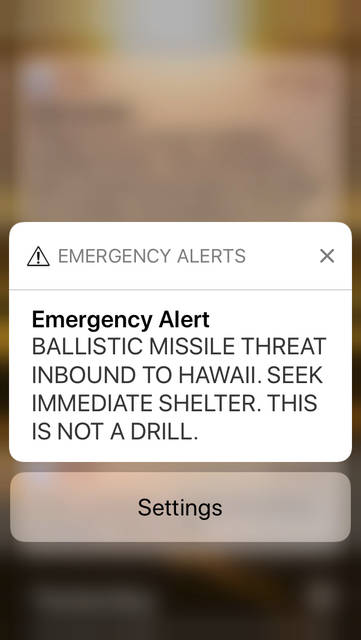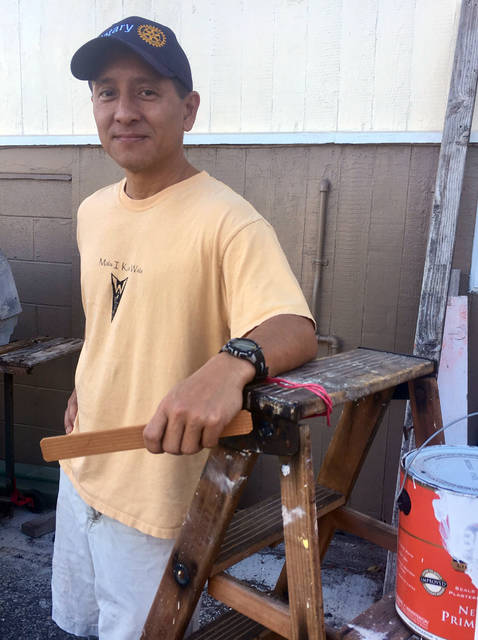HONOLULU — A push alert that warned of a ballistic missile heading straight for Hawaii and sent residents into a full-blown panic Saturday was issued by mistake, state emergency officials said.
The emergency alert, which was sent to cellphones just before 8:10 a.m., said in all caps, “Ballistic missile threat inbound to Hawaii. Seek immediate shelter. This is not a drill.” The Hawaii Emergency Management Agency tweeted that there was no threat about 10 minutes later. But a revised push alert stating there was no threat went out sometime after that.
Agency spokesman Richard Repoza confirmed it was a false alarm and the agency is trying to determine what happened.
The incident prompted defense agencies including the Pentagon and the U.S. Pacific Command to issue the same statement, that they had “detected no ballistic missile threat to Hawaii.”
Michael Kucharek, spokesman for the North American Aerospace Defense Command in Colorado Springs, Colorado, said NORAD and the U.S. Northern Command are still trying to verify what happened in Hawaii — but that “NORAD did not see anything that indicated any sort of threat to Hawaii.”
NORAD is a U.S.-Canada joint command that conducts aerospace warning, aerospace control and maritime warning to defend North America.
The White House said President Donald Trump, who is in Florida, was briefed on the false alert. White House spokeswoman Lindsay Walters said it “was purely a state exercise.”
The alert caused a tizzy on the island and across social media.
At the PGA Tour’s Sony Open on Oahu, Waialae Country Club was largely empty and players were still a few hours from arriving when the alert showed up. The tournament staff urged the media center to evacuate. A local radio show from the clubhouse, next to glass windows that overlook the Pacific, kept broadcasting. Staff members at the club streamed into the clubhouse and tried to seek cover in the locker room, which was filled with the players’ golf bags, but instead went into the kitchen.
Several players took to Twitter.
“Just woke up here in Hawaii to this lovely text. Somebody can verify this?” tweeted Emiliano Grillo of Argentina.
Justin Thomas, the PGA Tour player of the year, tweeted, “To all that just received the warning along with me this morning … apparently it was a ‘mistake’?? hell of a mistake!! Haha glad to know we’ll all be safe.”
In Honolulu, Jaime Malapit, owner of a hair salon, texted his clients that he was cancelling their appointments and was closing his shop for the day. He said he was still in bed when the phone started going off “like crazy.” He thought it was a tsunami warning at first.
“I woke up and saw a missile warning and thought ‘no way.’ I thought ‘No, this is not happening today,’” Malapit said.
He was still “a little freaked out” and feeling paranoid even after hearing it was a false alarm.
Richard Ing, a Honolulu attorney, was doing a construction project at home when his wife told him about the alert.
He dug his phone out and had confirmed he had the same alert. Attempts to find further information on the television or radio didn’t provide further information, but then he saw on Twitter that it was a false alarm.
While he was trying to confirm, his wife and children were preparing to evacuate in case they needed to move to safer ground.
After finding out it was a mistake, Ing tried to find some humor in the situation.
“I thought to myself, it must be someone’s last day at work or someone got extremely upset at a superior and basically did this as a practical joke,’ he said. “But I think it’s a very serious problem if it wasn’t that, or even it was, it shows that we have problems in the system that can cause major disruption and panic and anxiety among people in Hawaii.”
Others were outraged that such an alert could go out in error.
Hawaii U.S. Sen. Brian Schatz tweeted the false alarm was “totally inexcusable” and was caused by human error.
“There needs to be tough and quick accountability and a fixed process,” he wrote.
Federal Communications Commission Chairman Ajit Pai also took to social media to announce the panel would launch an investigation.
———
This story has been corrected to show that the Hawaii Emergency Management Agency tweeted that there was no threat about 10 minutes after false missile alert.
———
Associated Press writers Caleb Jones in Honolulu, Doug Ferguson in Maui, Mark Thiessen in Anchorage, Jim Anderson in Denver and Tom Strong in Washington contributed to this report.



